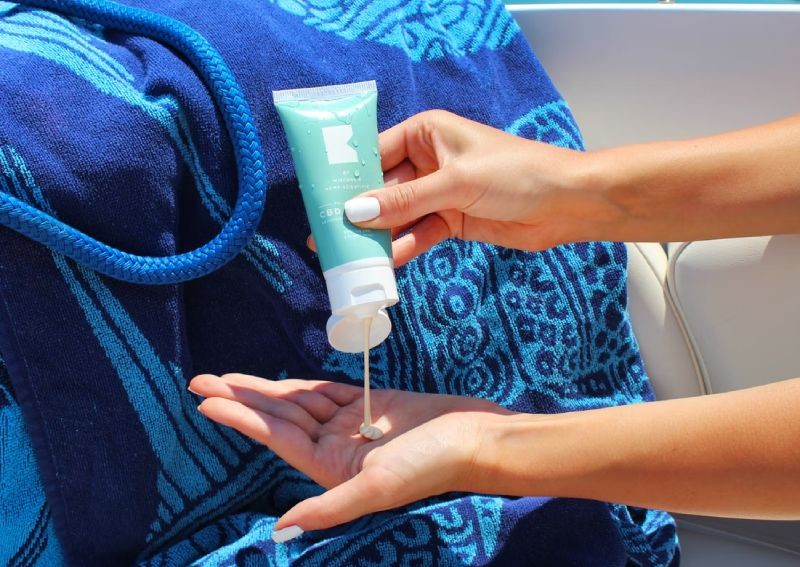Sunscreens that do more than just fight UV rays

Besides protecting against both harmful UVA and UVB rays, sunscreens today combine the best of both types of sun protection, while providing new improvements that hydrate, control acne, brighten dull skin, and combat excess blue light.
[embed]https://www.instagram.com/p/CXyaYsSpAu0/?utm_source=ig_embed&ig_rid=5c0b51ca-ba60-402c-901b-eabc6a38fd17[/embed]
What makes these sunscreens the miracle workers of our time: New advancements in technology, coupled with high levels of active skincare ingredients that correct specific problems such as acne and dullness, on top of offering higher SPF and broad- spectrum protection, without compromising on feel.
Take Japanese skincare brand Meeth for example.
Its F Bright UV Base ($70) promises constant hydration and a brightening effect, thanks to its fullerene molecule, used here as a powerful antioxidant.
Fullerene is 172 times more powerful than vitamin C, and its discovery won a Nobel Prize in 1996.
The winning ingredient is a nano-sized molecule that can penetrate deep into skin's layers easily.
[[nid:571983]]
Its ability to soak up free radicals slows down ageing and balances oil control, improving skin texture and suppressing melanin production in the process - a plus in a sunblock.
F Bright UV Base also contains another powerful ingredient: Pentavitin.
The 100 per cent natural and plant-derived hydrator features a composition that is most similar to skin's own cells, binding itself to the outer layers of skin.
It also mimics skin's own moisture retention. Unlike hyaluronic acid, it doesn't get washed away and keeps skin hydrated for up to 72 hours.
Another broad-spectrum sunscreen is Aloe Daily Suncream ($18) from Korean brand GTNC (Graceful, Trendy and Clean).
The brand's philosophy lies in combining the best of Korean botanicals like magnolia officinalis bark extract, stabilised vitamin C and other potent skincare actives in a streamlined skincare regime.
Aloe Daily Suncream packs seven types of hyaluronic acids to moisturise skin, while safeguarding its barrier. Its aloe leaf extract contains 300 different ingredients, such as beta-carotene to reduce UV light damage.
A fatty acid, beta-cytosterol, enhances the skin barrier function with antioxidants, and repairs inflammation from excess sun exposure, so skin stays protected and moisturised while in the sun.
Physical or mineral sunscreens are created with active mineral ingredients like zinc oxide and titanium dioxide.
They create a physical barrier to block and reflect UV rays before they hit skin's surface. The mineral particles from zinc oxide and titanium dioxide that sit on the skin work instantly - so there's no need to apply 15 or 20 minutes before sun exposure.
Chemical sunscreens, on the other hand, are made of organic chemical compounds. Instead of deflecting UV rays, these sunscreens act like sponges, absorbing UV light and converting it into heat that dissipates from the surface of your skin.
These sunscreens are typically lightweight and easy to apply, and don't leave a white cast, but you will need to apply them at least 20 minutes before sun exposure.
A quick look at every tube or bottle will show these acronyms.
UVA stands for Ultraviolet A rays that have longer wavelengths, and are often associated with signs of ageing. UVB stands for Ultraviolet B, which has a shorter wavelength and tends to cause sunburn.
Your skin can be protected against UVA rays with products that have a PA+ rating. This is a rating system developed in Japan to show how much UVA protection the product has.
PA+ for some UVA protection, PA++ for moderate UVA protection, and PA+++ for high UVA protection.
You can also protect your skin against UVB rays by using sunscreens with a Sun Protection Factor (or SPF) rating.
This is denoted by the number after the letters SPF. The number can range anywhere from 15 to 50 and above.
It reflects the length of time your skin is protected from UVB rays before it burns. This number is not foolproof though.
Research has shown that even though a higher SPF is more likely to prevent sunburns, factors like sweat, humidity, and going into the water or sea can impact your sunscreen's efficacy.
So no matter what, reapply your sunscreen every two hours. In short, a good sunscreen is one that is broad spectrum, protecting your skin from both types of UV radiation.

This shimmery body lotion adds a healthy glow to skin and includes the antioxidative prowess of white stargrass to brighten, and moisturising coconut alkanes for a silky-smooth finish.
It gives broad spectrum protection and contains BHAs and salicylic acid to decongest skin.
Available at Sephora.

Happy Skin was created by a pair of beauty veterans in the Philippines.
Rescue Me Sun Gel Primer is slightly tinted to provide light coverage, and helps strengthen the skin barrier with ceramides.
What's more, it leaves a fresh, dewy finish and hydrates skin with hyaluronic acid, scoring full marks when worn under makeup.
Available at Beaubit.co.

Keep breakouts at bay with this lightweight matte moisturiser that has antioxidants willow bark and green tea extract to combat pollution.
Its pore protection shield creates an invisible barrier between the product and skin to prevent your pores from getting clogged.
Available at Sephora.
This article was first published in Her World Online.